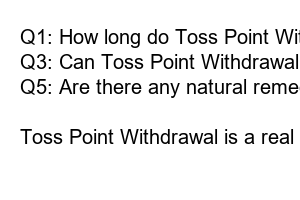토스 포인트 출금
Title: Understanding Toss Point Withdrawal Symptoms: Get Relief and Regain Control
Introduction:
Toss Point Withdrawal is a condition that many individuals experience when they try to reduce or quit the use of social media platforms. The overwhelming urge to constantly check notifications, scroll through feeds, and seek virtual validation can become a source of dependency, causing distressing withdrawal symptoms. In this blog post, we will delve into the various symptoms of Toss Point Withdrawal, its potential causes, and effective strategies to overcome it.
1. What is Toss Point Withdrawal?
Toss Point Withdrawal refers to the psychological and emotional symptoms experienced by individuals who attempt to distance themselves from frequent social media use. These symptoms develop as a result of the brain’s craving for the instant gratification and constant stimulation that social media provides.
2. Common Symptoms of Toss Point Withdrawal:
– Anxiety and restlessness when unable to access social media
– Irritability and mood swings
– Difficulty concentrating on tasks
– Feelings of isolation and FOMO (Fear of Missing Out)
– Insomnia or changes in sleeping patterns
– The compulsion to “check in” on social media platforms even when not necessary
– Loss of interest in real-life activities and difficulty establishing personal connections
3. What Causes Toss Point Withdrawal?
– Dopamine: Social media platforms trigger the release of dopamine, known as the “reward hormone.” When individuals are unable to replicate this dopamine surge, withdrawal symptoms can occur.
– Social Pressure: The fear of missing out on social events or feeling left out can lead individuals to relentlessly check social media, reinforcing dependency.
– Emotional Validation: Internet-based interactions can create a sense of validation, which becomes addictive over time. The absence of constant approval can trigger withdrawal symptoms.
4. Coping Strategies for Toss Point Withdrawal:
– Limit Social Media Use: Gradually decrease the time spent on social media platforms to help break the addiction cycle.
– Engage in Real-Life Activities: Rediscover hobbies, exercise, spend time with loved ones, and engage in activities that provide a sense of fulfillment.
– Create a Support System: Talk to friends, family, or seek professional help to share concerns and seek strategies to overcome the challenges associated with withdrawal.
5. Implementing Digital Detox:
– Start with Small Steps: Begin by designating specific times when you resist accessing social media and gradually increase the duration.
– Remove Notifications: Disable unnecessary notifications to reduce the temptation for frequent social media checks.
– Use Time Management Apps: Utilize various apps that help monitor and limit screen time, providing structure to your online habits.
6. Frequently Asked Questions (FAQs):
Q1: How long do Toss Point Withdrawal symptoms last?
Q2: Is it necessary to completely avoid social media?
Q3: Can Toss Point Withdrawal lead to other mental health issues?
Q4: How can I resist the urge to constantly check social media?
Q5: Are there any natural remedies to alleviate Toss Point Withdrawal symptoms?
Q6: Can professional therapy or counseling be beneficial in overcoming Toss Point Withdrawal?
Summary:
Toss Point Withdrawal is a real phenomenon affecting individuals who struggle with the addictive nature of social media platforms. By recognizing the symptoms and implementing effective coping strategies, such as limiting usage, engaging in real-life activities, and seeking support, it is possible to navigate the challenges and regain control over one’s digital habits, leading to a healthier and more balanced lifestyle.

